MOD004054 - Healthcare Environment
VerifiedAdded on 2021/09/23
|12
|3122
|182
AI Summary
Contribute Materials
Your contribution can guide someone’s learning journey. Share your
documents today.

Health Care Environment 1
HEALTH CARE ENVIRONMENT
By [Name]
Course
Professor’s Name
Institution
Location of Institution
Date
HEALTH CARE ENVIRONMENT
By [Name]
Course
Professor’s Name
Institution
Location of Institution
Date
Secure Best Marks with AI Grader
Need help grading? Try our AI Grader for instant feedback on your assignments.
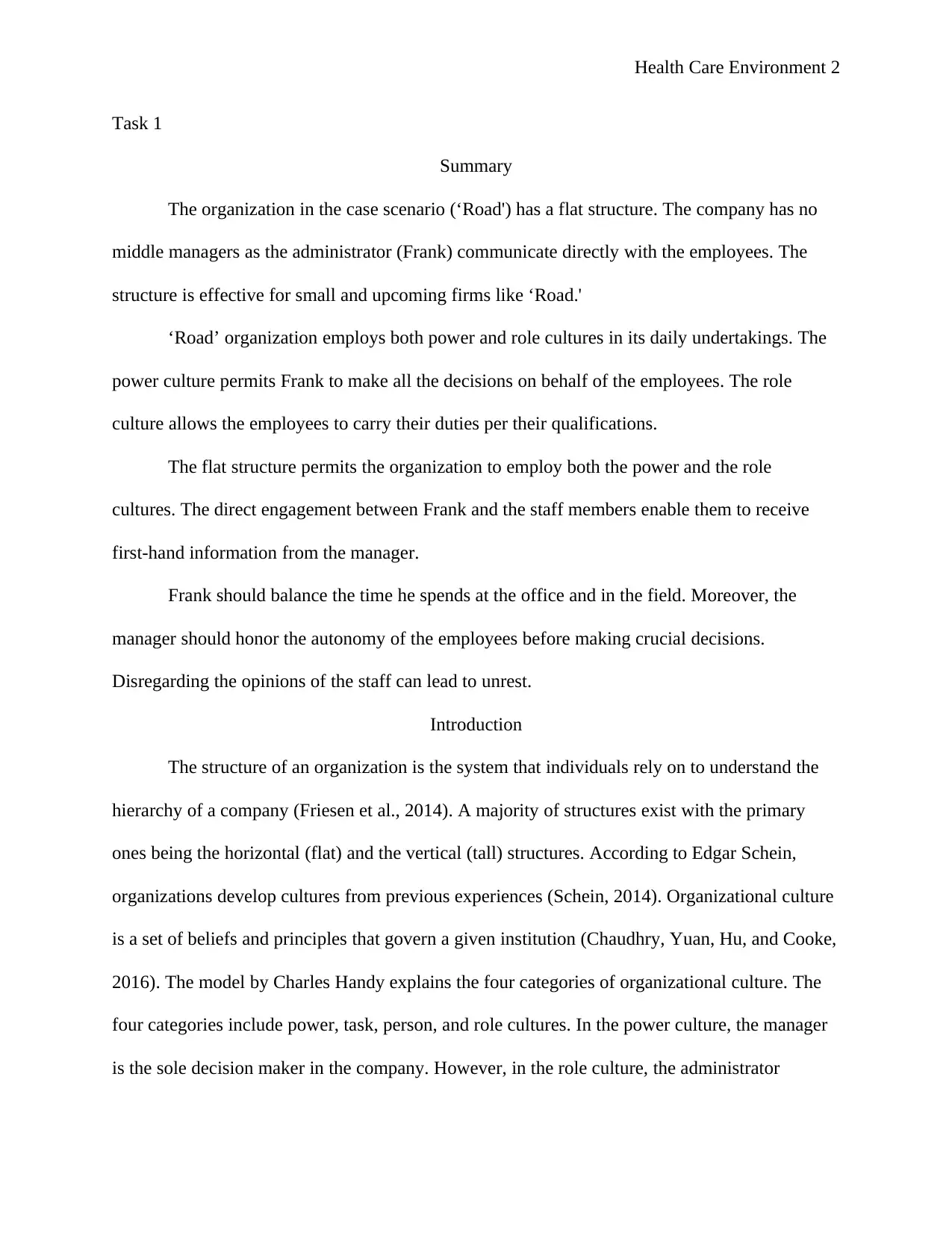
Health Care Environment 2
Task 1
Summary
The organization in the case scenario (‘Road') has a flat structure. The company has no
middle managers as the administrator (Frank) communicate directly with the employees. The
structure is effective for small and upcoming firms like ‘Road.'
‘Road’ organization employs both power and role cultures in its daily undertakings. The
power culture permits Frank to make all the decisions on behalf of the employees. The role
culture allows the employees to carry their duties per their qualifications.
The flat structure permits the organization to employ both the power and the role
cultures. The direct engagement between Frank and the staff members enable them to receive
first-hand information from the manager.
Frank should balance the time he spends at the office and in the field. Moreover, the
manager should honor the autonomy of the employees before making crucial decisions.
Disregarding the opinions of the staff can lead to unrest.
Introduction
The structure of an organization is the system that individuals rely on to understand the
hierarchy of a company (Friesen et al., 2014). A majority of structures exist with the primary
ones being the horizontal (flat) and the vertical (tall) structures. According to Edgar Schein,
organizations develop cultures from previous experiences (Schein, 2014). Organizational culture
is a set of beliefs and principles that govern a given institution (Chaudhry, Yuan, Hu, and Cooke,
2016). The model by Charles Handy explains the four categories of organizational culture. The
four categories include power, task, person, and role cultures. In the power culture, the manager
is the sole decision maker in the company. However, in the role culture, the administrator
Task 1
Summary
The organization in the case scenario (‘Road') has a flat structure. The company has no
middle managers as the administrator (Frank) communicate directly with the employees. The
structure is effective for small and upcoming firms like ‘Road.'
‘Road’ organization employs both power and role cultures in its daily undertakings. The
power culture permits Frank to make all the decisions on behalf of the employees. The role
culture allows the employees to carry their duties per their qualifications.
The flat structure permits the organization to employ both the power and the role
cultures. The direct engagement between Frank and the staff members enable them to receive
first-hand information from the manager.
Frank should balance the time he spends at the office and in the field. Moreover, the
manager should honor the autonomy of the employees before making crucial decisions.
Disregarding the opinions of the staff can lead to unrest.
Introduction
The structure of an organization is the system that individuals rely on to understand the
hierarchy of a company (Friesen et al., 2014). A majority of structures exist with the primary
ones being the horizontal (flat) and the vertical (tall) structures. According to Edgar Schein,
organizations develop cultures from previous experiences (Schein, 2014). Organizational culture
is a set of beliefs and principles that govern a given institution (Chaudhry, Yuan, Hu, and Cooke,
2016). The model by Charles Handy explains the four categories of organizational culture. The
four categories include power, task, person, and role cultures. In the power culture, the manager
is the sole decision maker in the company. However, in the role culture, the administrator
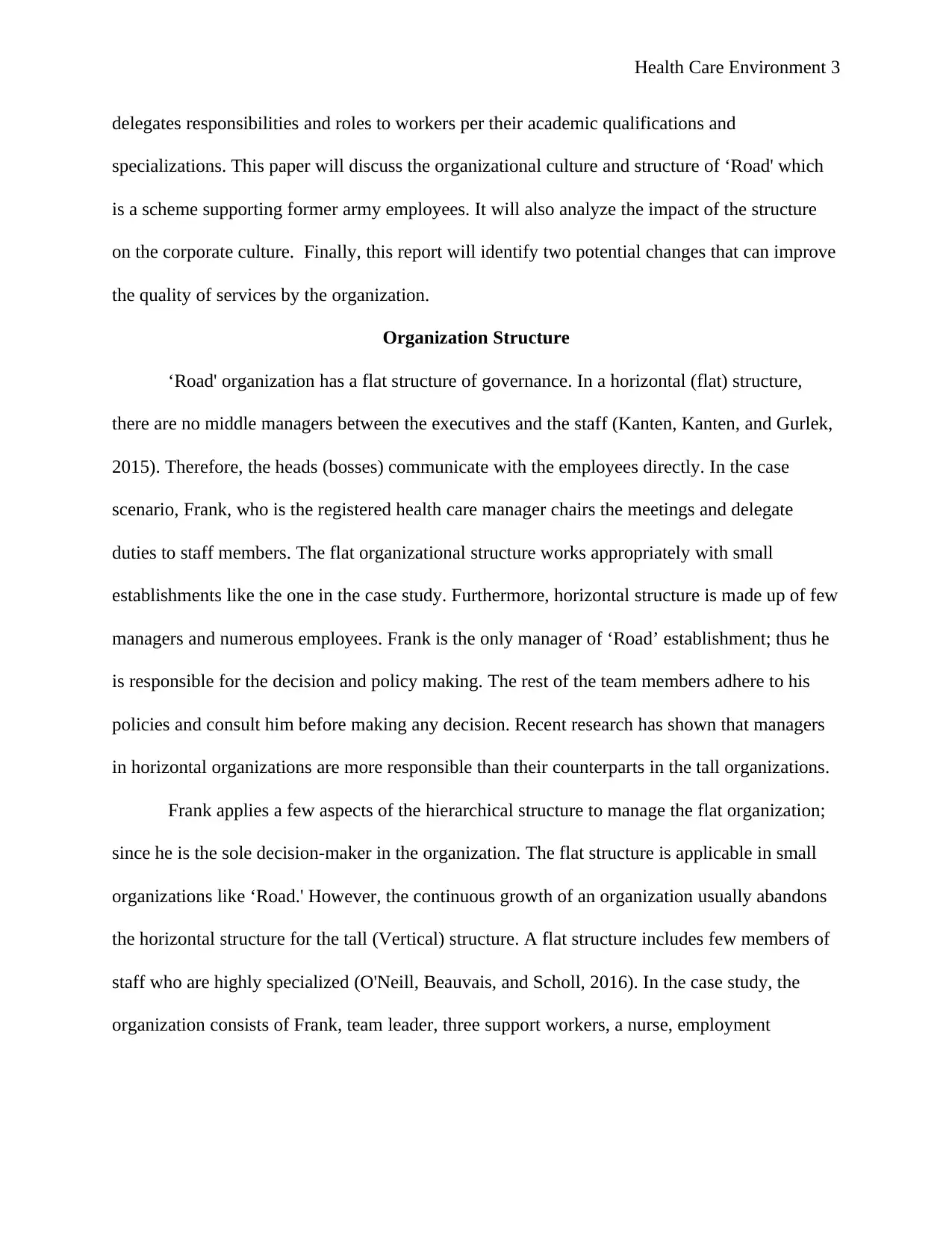
Health Care Environment 3
delegates responsibilities and roles to workers per their academic qualifications and
specializations. This paper will discuss the organizational culture and structure of ‘Road' which
is a scheme supporting former army employees. It will also analyze the impact of the structure
on the corporate culture. Finally, this report will identify two potential changes that can improve
the quality of services by the organization.
Organization Structure
‘Road' organization has a flat structure of governance. In a horizontal (flat) structure,
there are no middle managers between the executives and the staff (Kanten, Kanten, and Gurlek,
2015). Therefore, the heads (bosses) communicate with the employees directly. In the case
scenario, Frank, who is the registered health care manager chairs the meetings and delegate
duties to staff members. The flat organizational structure works appropriately with small
establishments like the one in the case study. Furthermore, horizontal structure is made up of few
managers and numerous employees. Frank is the only manager of ‘Road’ establishment; thus he
is responsible for the decision and policy making. The rest of the team members adhere to his
policies and consult him before making any decision. Recent research has shown that managers
in horizontal organizations are more responsible than their counterparts in the tall organizations.
Frank applies a few aspects of the hierarchical structure to manage the flat organization;
since he is the sole decision-maker in the organization. The flat structure is applicable in small
organizations like ‘Road.' However, the continuous growth of an organization usually abandons
the horizontal structure for the tall (Vertical) structure. A flat structure includes few members of
staff who are highly specialized (O'Neill, Beauvais, and Scholl, 2016). In the case study, the
organization consists of Frank, team leader, three support workers, a nurse, employment
delegates responsibilities and roles to workers per their academic qualifications and
specializations. This paper will discuss the organizational culture and structure of ‘Road' which
is a scheme supporting former army employees. It will also analyze the impact of the structure
on the corporate culture. Finally, this report will identify two potential changes that can improve
the quality of services by the organization.
Organization Structure
‘Road' organization has a flat structure of governance. In a horizontal (flat) structure,
there are no middle managers between the executives and the staff (Kanten, Kanten, and Gurlek,
2015). Therefore, the heads (bosses) communicate with the employees directly. In the case
scenario, Frank, who is the registered health care manager chairs the meetings and delegate
duties to staff members. The flat organizational structure works appropriately with small
establishments like the one in the case study. Furthermore, horizontal structure is made up of few
managers and numerous employees. Frank is the only manager of ‘Road’ establishment; thus he
is responsible for the decision and policy making. The rest of the team members adhere to his
policies and consult him before making any decision. Recent research has shown that managers
in horizontal organizations are more responsible than their counterparts in the tall organizations.
Frank applies a few aspects of the hierarchical structure to manage the flat organization;
since he is the sole decision-maker in the organization. The flat structure is applicable in small
organizations like ‘Road.' However, the continuous growth of an organization usually abandons
the horizontal structure for the tall (Vertical) structure. A flat structure includes few members of
staff who are highly specialized (O'Neill, Beauvais, and Scholl, 2016). In the case study, the
organization consists of Frank, team leader, three support workers, a nurse, employment
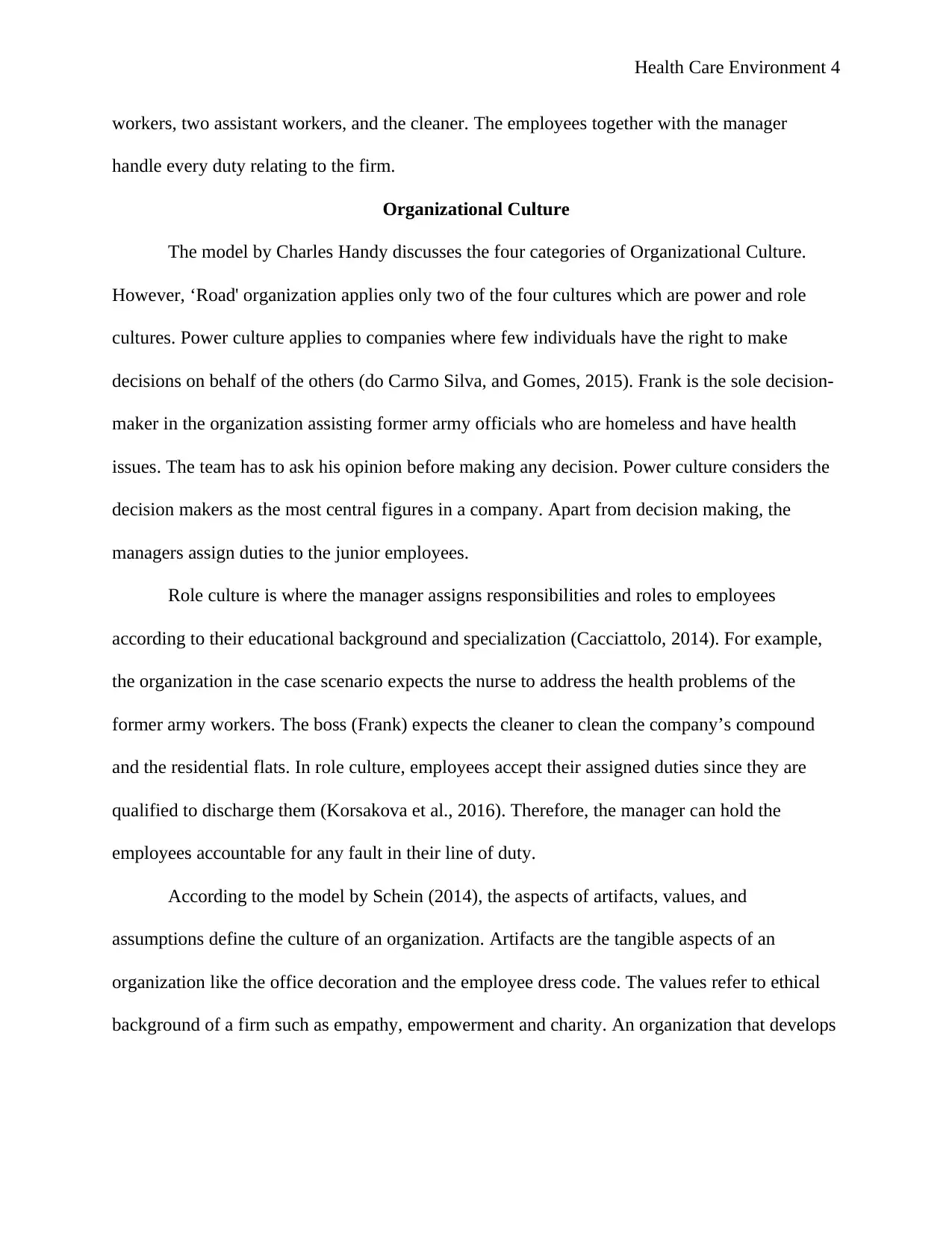
Health Care Environment 4
workers, two assistant workers, and the cleaner. The employees together with the manager
handle every duty relating to the firm.
Organizational Culture
The model by Charles Handy discusses the four categories of Organizational Culture.
However, ‘Road' organization applies only two of the four cultures which are power and role
cultures. Power culture applies to companies where few individuals have the right to make
decisions on behalf of the others (do Carmo Silva, and Gomes, 2015). Frank is the sole decision-
maker in the organization assisting former army officials who are homeless and have health
issues. The team has to ask his opinion before making any decision. Power culture considers the
decision makers as the most central figures in a company. Apart from decision making, the
managers assign duties to the junior employees.
Role culture is where the manager assigns responsibilities and roles to employees
according to their educational background and specialization (Cacciattolo, 2014). For example,
the organization in the case scenario expects the nurse to address the health problems of the
former army workers. The boss (Frank) expects the cleaner to clean the company’s compound
and the residential flats. In role culture, employees accept their assigned duties since they are
qualified to discharge them (Korsakova et al., 2016). Therefore, the manager can hold the
employees accountable for any fault in their line of duty.
According to the model by Schein (2014), the aspects of artifacts, values, and
assumptions define the culture of an organization. Artifacts are the tangible aspects of an
organization like the office decoration and the employee dress code. The values refer to ethical
background of a firm such as empathy, empowerment and charity. An organization that develops
workers, two assistant workers, and the cleaner. The employees together with the manager
handle every duty relating to the firm.
Organizational Culture
The model by Charles Handy discusses the four categories of Organizational Culture.
However, ‘Road' organization applies only two of the four cultures which are power and role
cultures. Power culture applies to companies where few individuals have the right to make
decisions on behalf of the others (do Carmo Silva, and Gomes, 2015). Frank is the sole decision-
maker in the organization assisting former army officials who are homeless and have health
issues. The team has to ask his opinion before making any decision. Power culture considers the
decision makers as the most central figures in a company. Apart from decision making, the
managers assign duties to the junior employees.
Role culture is where the manager assigns responsibilities and roles to employees
according to their educational background and specialization (Cacciattolo, 2014). For example,
the organization in the case scenario expects the nurse to address the health problems of the
former army workers. The boss (Frank) expects the cleaner to clean the company’s compound
and the residential flats. In role culture, employees accept their assigned duties since they are
qualified to discharge them (Korsakova et al., 2016). Therefore, the manager can hold the
employees accountable for any fault in their line of duty.
According to the model by Schein (2014), the aspects of artifacts, values, and
assumptions define the culture of an organization. Artifacts are the tangible aspects of an
organization like the office decoration and the employee dress code. The values refer to ethical
background of a firm such as empathy, empowerment and charity. An organization that develops
Secure Best Marks with AI Grader
Need help grading? Try our AI Grader for instant feedback on your assignments.
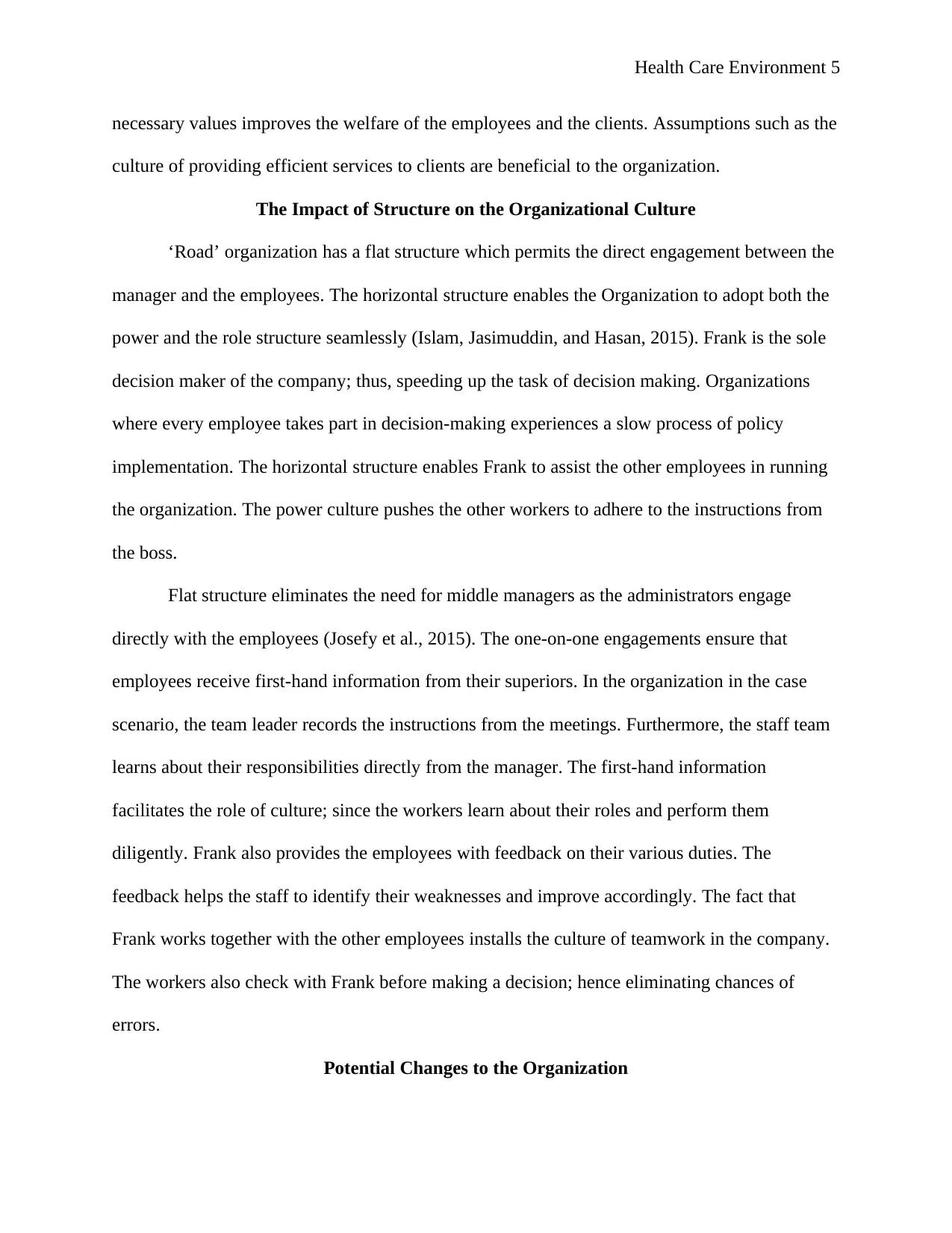
Health Care Environment 5
necessary values improves the welfare of the employees and the clients. Assumptions such as the
culture of providing efficient services to clients are beneficial to the organization.
The Impact of Structure on the Organizational Culture
‘Road’ organization has a flat structure which permits the direct engagement between the
manager and the employees. The horizontal structure enables the Organization to adopt both the
power and the role structure seamlessly (Islam, Jasimuddin, and Hasan, 2015). Frank is the sole
decision maker of the company; thus, speeding up the task of decision making. Organizations
where every employee takes part in decision-making experiences a slow process of policy
implementation. The horizontal structure enables Frank to assist the other employees in running
the organization. The power culture pushes the other workers to adhere to the instructions from
the boss.
Flat structure eliminates the need for middle managers as the administrators engage
directly with the employees (Josefy et al., 2015). The one-on-one engagements ensure that
employees receive first-hand information from their superiors. In the organization in the case
scenario, the team leader records the instructions from the meetings. Furthermore, the staff team
learns about their responsibilities directly from the manager. The first-hand information
facilitates the role of culture; since the workers learn about their roles and perform them
diligently. Frank also provides the employees with feedback on their various duties. The
feedback helps the staff to identify their weaknesses and improve accordingly. The fact that
Frank works together with the other employees installs the culture of teamwork in the company.
The workers also check with Frank before making a decision; hence eliminating chances of
errors.
Potential Changes to the Organization
necessary values improves the welfare of the employees and the clients. Assumptions such as the
culture of providing efficient services to clients are beneficial to the organization.
The Impact of Structure on the Organizational Culture
‘Road’ organization has a flat structure which permits the direct engagement between the
manager and the employees. The horizontal structure enables the Organization to adopt both the
power and the role structure seamlessly (Islam, Jasimuddin, and Hasan, 2015). Frank is the sole
decision maker of the company; thus, speeding up the task of decision making. Organizations
where every employee takes part in decision-making experiences a slow process of policy
implementation. The horizontal structure enables Frank to assist the other employees in running
the organization. The power culture pushes the other workers to adhere to the instructions from
the boss.
Flat structure eliminates the need for middle managers as the administrators engage
directly with the employees (Josefy et al., 2015). The one-on-one engagements ensure that
employees receive first-hand information from their superiors. In the organization in the case
scenario, the team leader records the instructions from the meetings. Furthermore, the staff team
learns about their responsibilities directly from the manager. The first-hand information
facilitates the role of culture; since the workers learn about their roles and perform them
diligently. Frank also provides the employees with feedback on their various duties. The
feedback helps the staff to identify their weaknesses and improve accordingly. The fact that
Frank works together with the other employees installs the culture of teamwork in the company.
The workers also check with Frank before making a decision; hence eliminating chances of
errors.
Potential Changes to the Organization
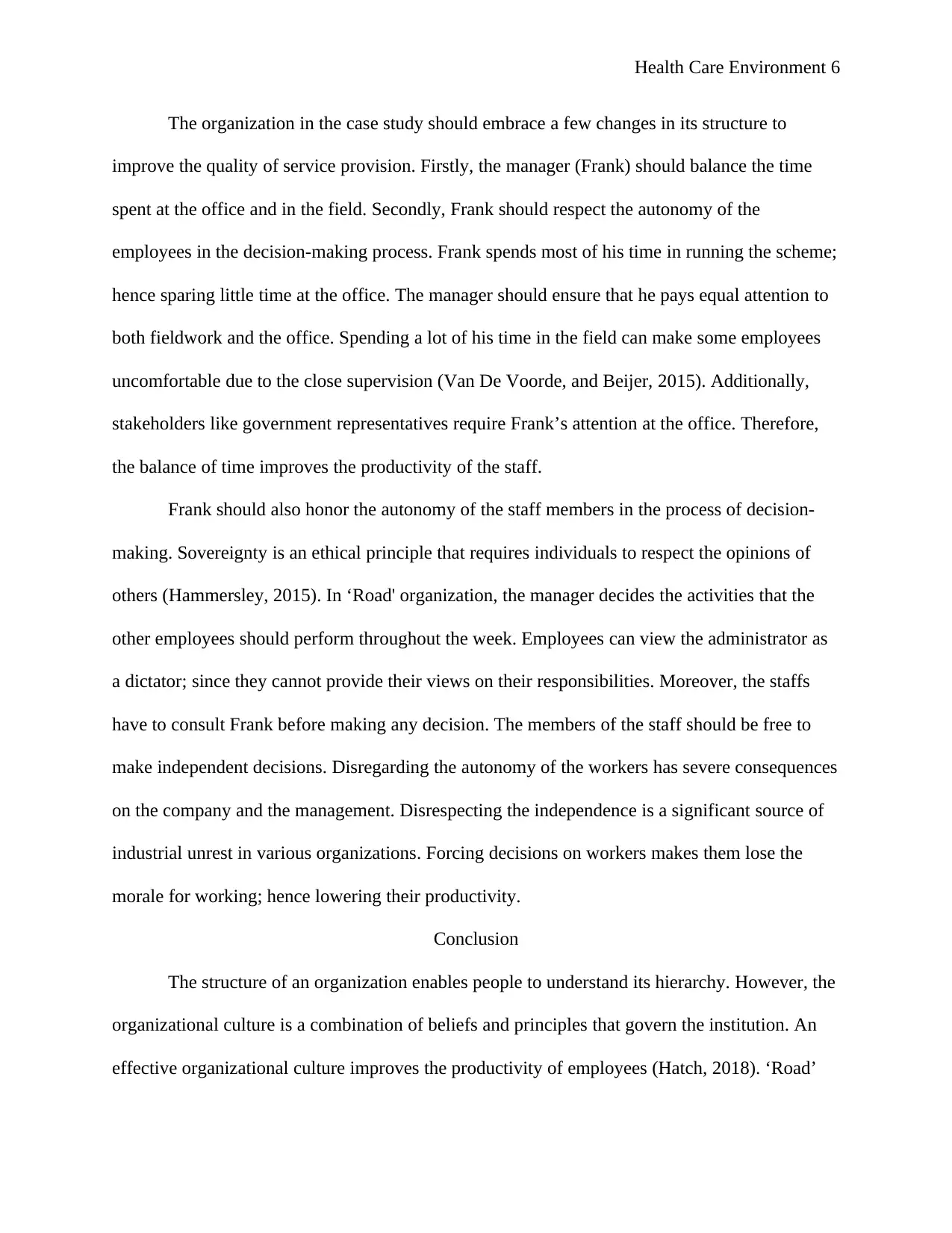
Health Care Environment 6
The organization in the case study should embrace a few changes in its structure to
improve the quality of service provision. Firstly, the manager (Frank) should balance the time
spent at the office and in the field. Secondly, Frank should respect the autonomy of the
employees in the decision-making process. Frank spends most of his time in running the scheme;
hence sparing little time at the office. The manager should ensure that he pays equal attention to
both fieldwork and the office. Spending a lot of his time in the field can make some employees
uncomfortable due to the close supervision (Van De Voorde, and Beijer, 2015). Additionally,
stakeholders like government representatives require Frank’s attention at the office. Therefore,
the balance of time improves the productivity of the staff.
Frank should also honor the autonomy of the staff members in the process of decision-
making. Sovereignty is an ethical principle that requires individuals to respect the opinions of
others (Hammersley, 2015). In ‘Road' organization, the manager decides the activities that the
other employees should perform throughout the week. Employees can view the administrator as
a dictator; since they cannot provide their views on their responsibilities. Moreover, the staffs
have to consult Frank before making any decision. The members of the staff should be free to
make independent decisions. Disregarding the autonomy of the workers has severe consequences
on the company and the management. Disrespecting the independence is a significant source of
industrial unrest in various organizations. Forcing decisions on workers makes them lose the
morale for working; hence lowering their productivity.
Conclusion
The structure of an organization enables people to understand its hierarchy. However, the
organizational culture is a combination of beliefs and principles that govern the institution. An
effective organizational culture improves the productivity of employees (Hatch, 2018). ‘Road’
The organization in the case study should embrace a few changes in its structure to
improve the quality of service provision. Firstly, the manager (Frank) should balance the time
spent at the office and in the field. Secondly, Frank should respect the autonomy of the
employees in the decision-making process. Frank spends most of his time in running the scheme;
hence sparing little time at the office. The manager should ensure that he pays equal attention to
both fieldwork and the office. Spending a lot of his time in the field can make some employees
uncomfortable due to the close supervision (Van De Voorde, and Beijer, 2015). Additionally,
stakeholders like government representatives require Frank’s attention at the office. Therefore,
the balance of time improves the productivity of the staff.
Frank should also honor the autonomy of the staff members in the process of decision-
making. Sovereignty is an ethical principle that requires individuals to respect the opinions of
others (Hammersley, 2015). In ‘Road' organization, the manager decides the activities that the
other employees should perform throughout the week. Employees can view the administrator as
a dictator; since they cannot provide their views on their responsibilities. Moreover, the staffs
have to consult Frank before making any decision. The members of the staff should be free to
make independent decisions. Disregarding the autonomy of the workers has severe consequences
on the company and the management. Disrespecting the independence is a significant source of
industrial unrest in various organizations. Forcing decisions on workers makes them lose the
morale for working; hence lowering their productivity.
Conclusion
The structure of an organization enables people to understand its hierarchy. However, the
organizational culture is a combination of beliefs and principles that govern the institution. An
effective organizational culture improves the productivity of employees (Hatch, 2018). ‘Road’
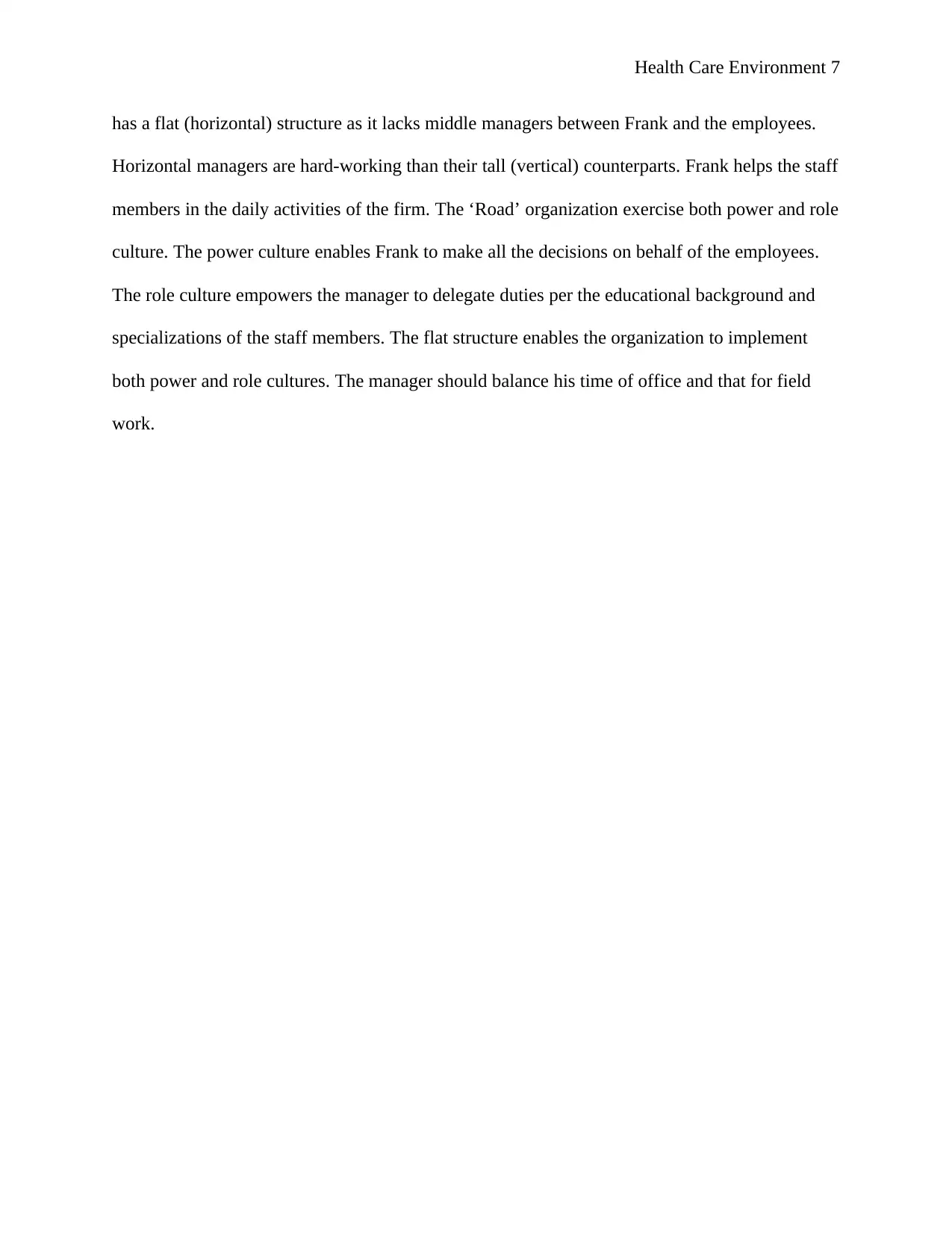
Health Care Environment 7
has a flat (horizontal) structure as it lacks middle managers between Frank and the employees.
Horizontal managers are hard-working than their tall (vertical) counterparts. Frank helps the staff
members in the daily activities of the firm. The ‘Road’ organization exercise both power and role
culture. The power culture enables Frank to make all the decisions on behalf of the employees.
The role culture empowers the manager to delegate duties per the educational background and
specializations of the staff members. The flat structure enables the organization to implement
both power and role cultures. The manager should balance his time of office and that for field
work.
has a flat (horizontal) structure as it lacks middle managers between Frank and the employees.
Horizontal managers are hard-working than their tall (vertical) counterparts. Frank helps the staff
members in the daily activities of the firm. The ‘Road’ organization exercise both power and role
culture. The power culture enables Frank to make all the decisions on behalf of the employees.
The role culture empowers the manager to delegate duties per the educational background and
specializations of the staff members. The flat structure enables the organization to implement
both power and role cultures. The manager should balance his time of office and that for field
work.
Paraphrase This Document
Need a fresh take? Get an instant paraphrase of this document with our AI Paraphraser
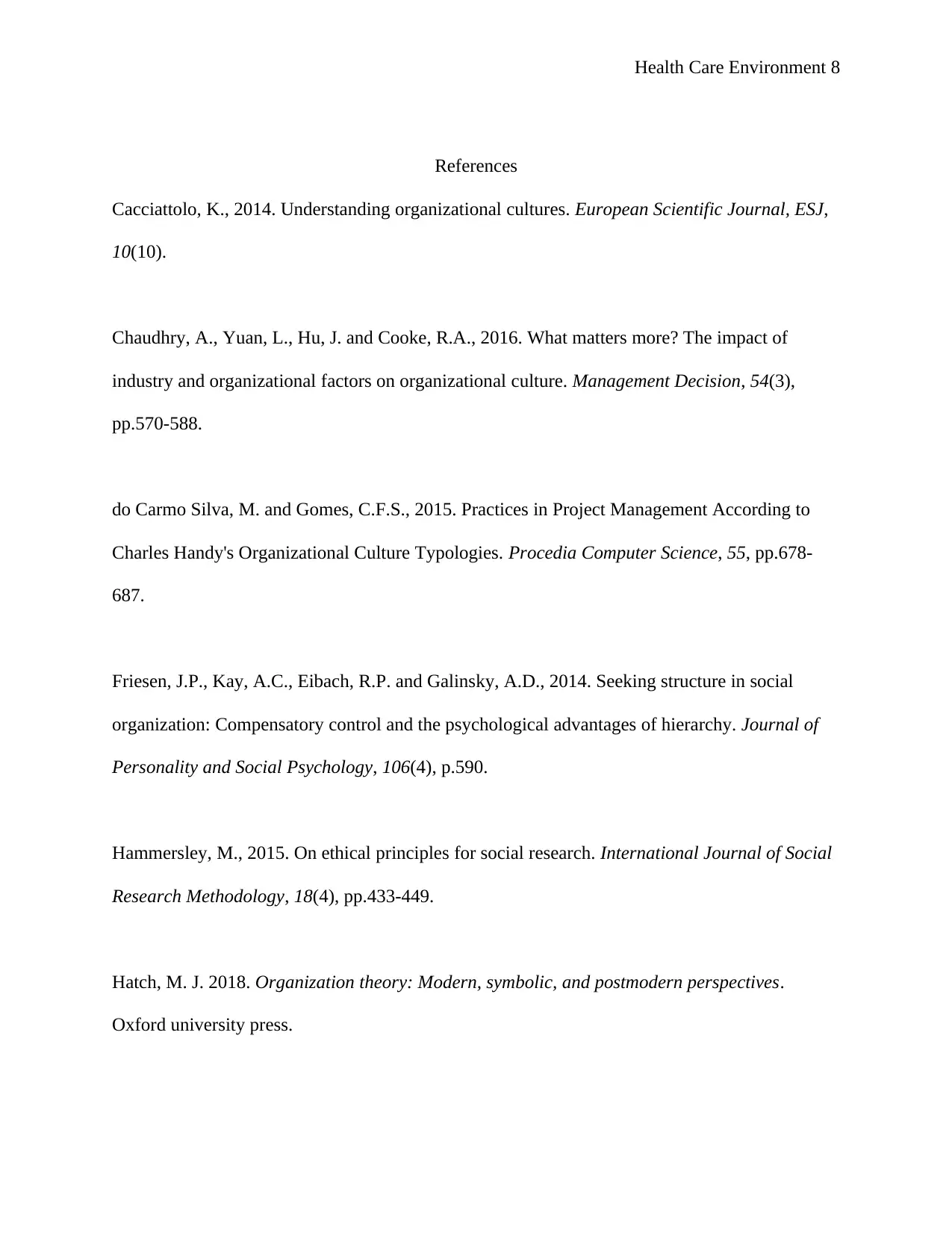
Health Care Environment 8
References
Cacciattolo, K., 2014. Understanding organizational cultures. European Scientific Journal, ESJ,
10(10).
Chaudhry, A., Yuan, L., Hu, J. and Cooke, R.A., 2016. What matters more? The impact of
industry and organizational factors on organizational culture. Management Decision, 54(3),
pp.570-588.
do Carmo Silva, M. and Gomes, C.F.S., 2015. Practices in Project Management According to
Charles Handy's Organizational Culture Typologies. Procedia Computer Science, 55, pp.678-
687.
Friesen, J.P., Kay, A.C., Eibach, R.P. and Galinsky, A.D., 2014. Seeking structure in social
organization: Compensatory control and the psychological advantages of hierarchy. Journal of
Personality and Social Psychology, 106(4), p.590.
Hammersley, M., 2015. On ethical principles for social research. International Journal of Social
Research Methodology, 18(4), pp.433-449.
Hatch, M. J. 2018. Organization theory: Modern, symbolic, and postmodern perspectives.
Oxford university press.
References
Cacciattolo, K., 2014. Understanding organizational cultures. European Scientific Journal, ESJ,
10(10).
Chaudhry, A., Yuan, L., Hu, J. and Cooke, R.A., 2016. What matters more? The impact of
industry and organizational factors on organizational culture. Management Decision, 54(3),
pp.570-588.
do Carmo Silva, M. and Gomes, C.F.S., 2015. Practices in Project Management According to
Charles Handy's Organizational Culture Typologies. Procedia Computer Science, 55, pp.678-
687.
Friesen, J.P., Kay, A.C., Eibach, R.P. and Galinsky, A.D., 2014. Seeking structure in social
organization: Compensatory control and the psychological advantages of hierarchy. Journal of
Personality and Social Psychology, 106(4), p.590.
Hammersley, M., 2015. On ethical principles for social research. International Journal of Social
Research Methodology, 18(4), pp.433-449.
Hatch, M. J. 2018. Organization theory: Modern, symbolic, and postmodern perspectives.
Oxford university press.
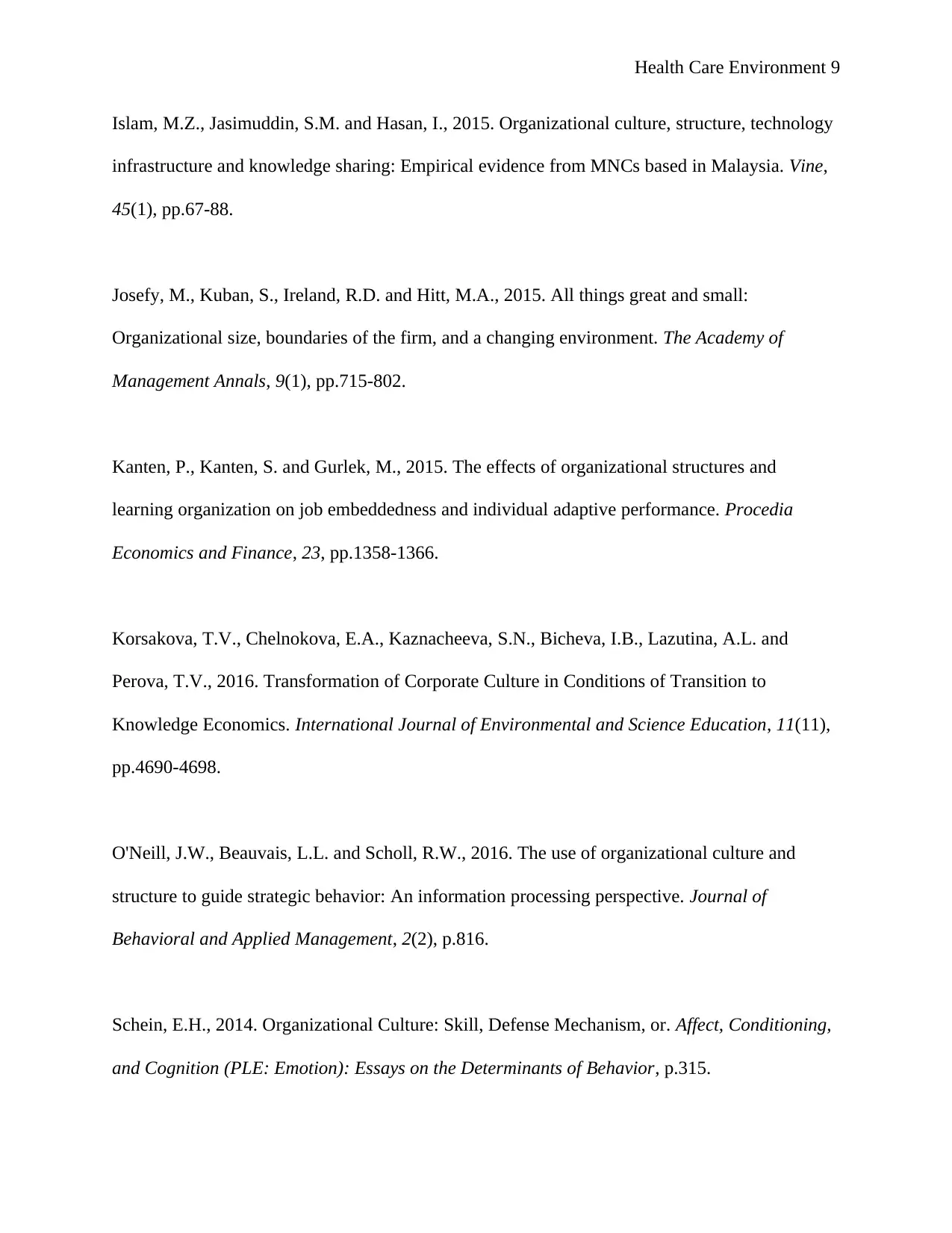
Health Care Environment 9
Islam, M.Z., Jasimuddin, S.M. and Hasan, I., 2015. Organizational culture, structure, technology
infrastructure and knowledge sharing: Empirical evidence from MNCs based in Malaysia. Vine,
45(1), pp.67-88.
Josefy, M., Kuban, S., Ireland, R.D. and Hitt, M.A., 2015. All things great and small:
Organizational size, boundaries of the firm, and a changing environment. The Academy of
Management Annals, 9(1), pp.715-802.
Kanten, P., Kanten, S. and Gurlek, M., 2015. The effects of organizational structures and
learning organization on job embeddedness and individual adaptive performance. Procedia
Economics and Finance, 23, pp.1358-1366.
Korsakova, T.V., Chelnokova, E.A., Kaznacheeva, S.N., Bicheva, I.B., Lazutina, A.L. and
Perova, T.V., 2016. Transformation of Corporate Culture in Conditions of Transition to
Knowledge Economics. International Journal of Environmental and Science Education, 11(11),
pp.4690-4698.
O'Neill, J.W., Beauvais, L.L. and Scholl, R.W., 2016. The use of organizational culture and
structure to guide strategic behavior: An information processing perspective. Journal of
Behavioral and Applied Management, 2(2), p.816.
Schein, E.H., 2014. Organizational Culture: Skill, Defense Mechanism, or. Affect, Conditioning,
and Cognition (PLE: Emotion): Essays on the Determinants of Behavior, p.315.
Islam, M.Z., Jasimuddin, S.M. and Hasan, I., 2015. Organizational culture, structure, technology
infrastructure and knowledge sharing: Empirical evidence from MNCs based in Malaysia. Vine,
45(1), pp.67-88.
Josefy, M., Kuban, S., Ireland, R.D. and Hitt, M.A., 2015. All things great and small:
Organizational size, boundaries of the firm, and a changing environment. The Academy of
Management Annals, 9(1), pp.715-802.
Kanten, P., Kanten, S. and Gurlek, M., 2015. The effects of organizational structures and
learning organization on job embeddedness and individual adaptive performance. Procedia
Economics and Finance, 23, pp.1358-1366.
Korsakova, T.V., Chelnokova, E.A., Kaznacheeva, S.N., Bicheva, I.B., Lazutina, A.L. and
Perova, T.V., 2016. Transformation of Corporate Culture in Conditions of Transition to
Knowledge Economics. International Journal of Environmental and Science Education, 11(11),
pp.4690-4698.
O'Neill, J.W., Beauvais, L.L. and Scholl, R.W., 2016. The use of organizational culture and
structure to guide strategic behavior: An information processing perspective. Journal of
Behavioral and Applied Management, 2(2), p.816.
Schein, E.H., 2014. Organizational Culture: Skill, Defense Mechanism, or. Affect, Conditioning,
and Cognition (PLE: Emotion): Essays on the Determinants of Behavior, p.315.
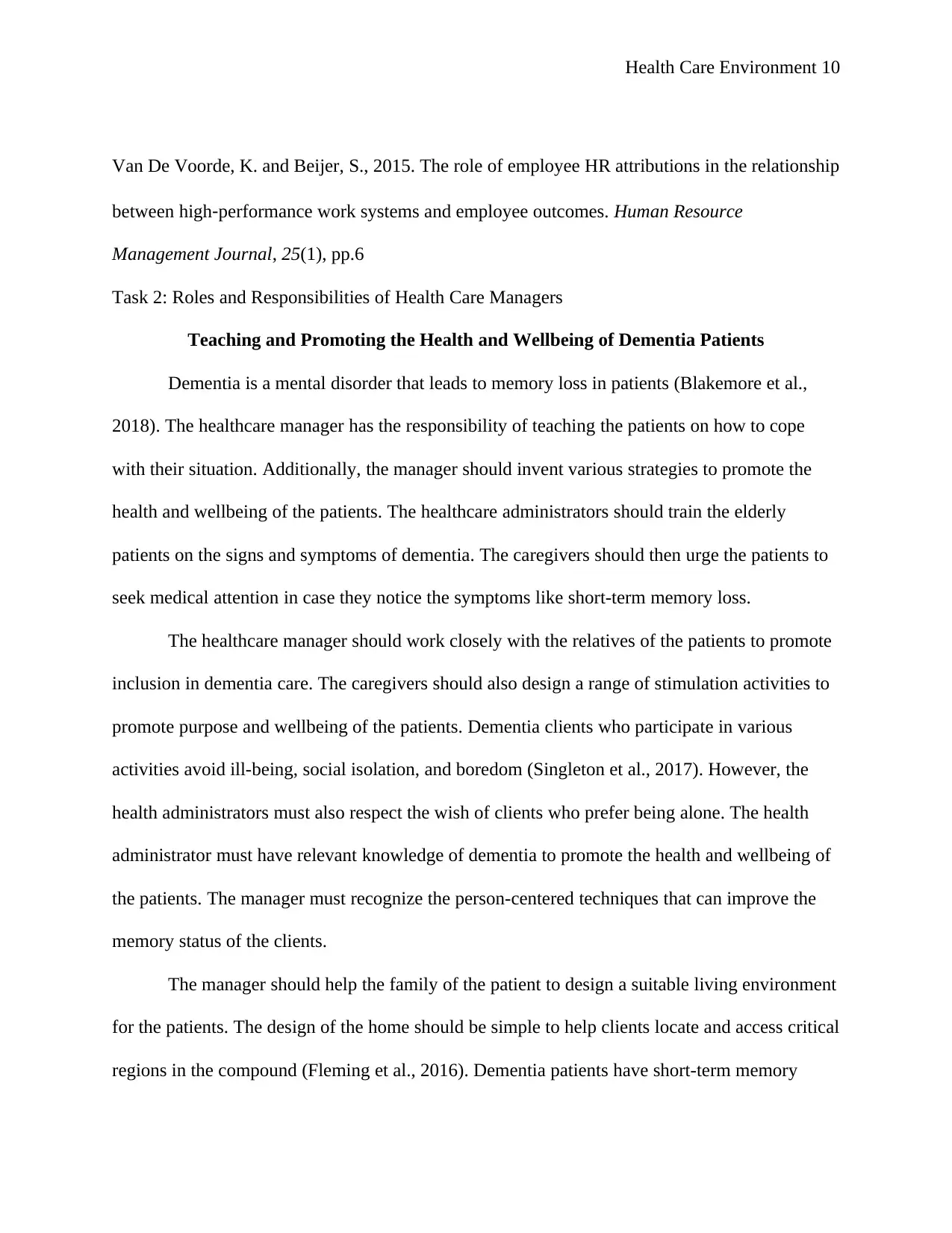
Health Care Environment 10
Van De Voorde, K. and Beijer, S., 2015. The role of employee HR attributions in the relationship
between high‐performance work systems and employee outcomes. Human Resource
Management Journal, 25(1), pp.6
Task 2: Roles and Responsibilities of Health Care Managers
Teaching and Promoting the Health and Wellbeing of Dementia Patients
Dementia is a mental disorder that leads to memory loss in patients (Blakemore et al.,
2018). The healthcare manager has the responsibility of teaching the patients on how to cope
with their situation. Additionally, the manager should invent various strategies to promote the
health and wellbeing of the patients. The healthcare administrators should train the elderly
patients on the signs and symptoms of dementia. The caregivers should then urge the patients to
seek medical attention in case they notice the symptoms like short-term memory loss.
The healthcare manager should work closely with the relatives of the patients to promote
inclusion in dementia care. The caregivers should also design a range of stimulation activities to
promote purpose and wellbeing of the patients. Dementia clients who participate in various
activities avoid ill-being, social isolation, and boredom (Singleton et al., 2017). However, the
health administrators must also respect the wish of clients who prefer being alone. The health
administrator must have relevant knowledge of dementia to promote the health and wellbeing of
the patients. The manager must recognize the person-centered techniques that can improve the
memory status of the clients.
The manager should help the family of the patient to design a suitable living environment
for the patients. The design of the home should be simple to help clients locate and access critical
regions in the compound (Fleming et al., 2016). Dementia patients have short-term memory
Van De Voorde, K. and Beijer, S., 2015. The role of employee HR attributions in the relationship
between high‐performance work systems and employee outcomes. Human Resource
Management Journal, 25(1), pp.6
Task 2: Roles and Responsibilities of Health Care Managers
Teaching and Promoting the Health and Wellbeing of Dementia Patients
Dementia is a mental disorder that leads to memory loss in patients (Blakemore et al.,
2018). The healthcare manager has the responsibility of teaching the patients on how to cope
with their situation. Additionally, the manager should invent various strategies to promote the
health and wellbeing of the patients. The healthcare administrators should train the elderly
patients on the signs and symptoms of dementia. The caregivers should then urge the patients to
seek medical attention in case they notice the symptoms like short-term memory loss.
The healthcare manager should work closely with the relatives of the patients to promote
inclusion in dementia care. The caregivers should also design a range of stimulation activities to
promote purpose and wellbeing of the patients. Dementia clients who participate in various
activities avoid ill-being, social isolation, and boredom (Singleton et al., 2017). However, the
health administrators must also respect the wish of clients who prefer being alone. The health
administrator must have relevant knowledge of dementia to promote the health and wellbeing of
the patients. The manager must recognize the person-centered techniques that can improve the
memory status of the clients.
The manager should help the family of the patient to design a suitable living environment
for the patients. The design of the home should be simple to help clients locate and access critical
regions in the compound (Fleming et al., 2016). Dementia patients have short-term memory
Secure Best Marks with AI Grader
Need help grading? Try our AI Grader for instant feedback on your assignments.
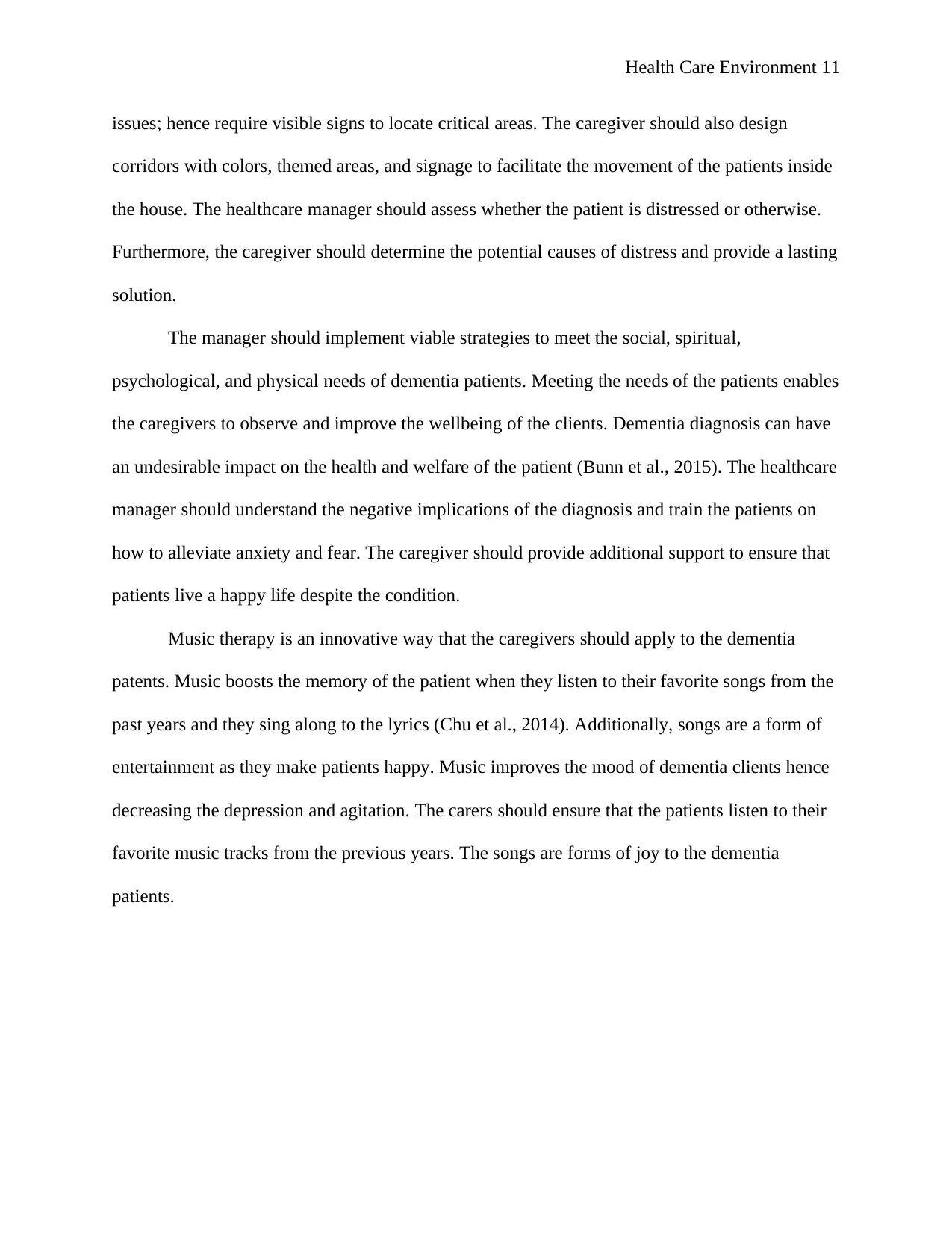
Health Care Environment 11
issues; hence require visible signs to locate critical areas. The caregiver should also design
corridors with colors, themed areas, and signage to facilitate the movement of the patients inside
the house. The healthcare manager should assess whether the patient is distressed or otherwise.
Furthermore, the caregiver should determine the potential causes of distress and provide a lasting
solution.
The manager should implement viable strategies to meet the social, spiritual,
psychological, and physical needs of dementia patients. Meeting the needs of the patients enables
the caregivers to observe and improve the wellbeing of the clients. Dementia diagnosis can have
an undesirable impact on the health and welfare of the patient (Bunn et al., 2015). The healthcare
manager should understand the negative implications of the diagnosis and train the patients on
how to alleviate anxiety and fear. The caregiver should provide additional support to ensure that
patients live a happy life despite the condition.
Music therapy is an innovative way that the caregivers should apply to the dementia
patents. Music boosts the memory of the patient when they listen to their favorite songs from the
past years and they sing along to the lyrics (Chu et al., 2014). Additionally, songs are a form of
entertainment as they make patients happy. Music improves the mood of dementia clients hence
decreasing the depression and agitation. The carers should ensure that the patients listen to their
favorite music tracks from the previous years. The songs are forms of joy to the dementia
patients.
issues; hence require visible signs to locate critical areas. The caregiver should also design
corridors with colors, themed areas, and signage to facilitate the movement of the patients inside
the house. The healthcare manager should assess whether the patient is distressed or otherwise.
Furthermore, the caregiver should determine the potential causes of distress and provide a lasting
solution.
The manager should implement viable strategies to meet the social, spiritual,
psychological, and physical needs of dementia patients. Meeting the needs of the patients enables
the caregivers to observe and improve the wellbeing of the clients. Dementia diagnosis can have
an undesirable impact on the health and welfare of the patient (Bunn et al., 2015). The healthcare
manager should understand the negative implications of the diagnosis and train the patients on
how to alleviate anxiety and fear. The caregiver should provide additional support to ensure that
patients live a happy life despite the condition.
Music therapy is an innovative way that the caregivers should apply to the dementia
patents. Music boosts the memory of the patient when they listen to their favorite songs from the
past years and they sing along to the lyrics (Chu et al., 2014). Additionally, songs are a form of
entertainment as they make patients happy. Music improves the mood of dementia clients hence
decreasing the depression and agitation. The carers should ensure that the patients listen to their
favorite music tracks from the previous years. The songs are forms of joy to the dementia
patients.

Health Care Environment 12
References
Blakemore, A., Kenning, C., Mirza, N., Daker-White, G., Panagioti, M. and Waheed, W., 2018.
Dementia in UK South Asians: a scoping review of the literature. BMJ Open, 8(4), p.e020290.
Bunn, F., Sworn, K., Brayne, C., Iliffe, S., Robinson, L. and Goodman, C., 2015.
Contextualizing the findings of a systematic review on patient and carer experiences of dementia
diagnosis and treatment: a qualitative study. Health Expectations, 18(5), pp.740-753.
Chu, H., Yang, C.Y., Lin, Y., Ou, K.L., Lee, T.Y., O’Brien, A.P. and Chou, K.R., 2014. The
impact of group music therapy on depression and cognition in elderly persons with dementia: a
randomized controlled study. Biological research for Nursing, 16(2), pp.209-217.
Fleming, R., Goodenough, B., Low, L.F., Chenoweth, L. and Brodaty, H., 2016. The relationship
between the quality of the built environment and the quality of life of people with dementia in
residential care. Dementia, 15(4), pp.663-680.
Singleton, D., Mukadam, N., Livingston, G. and Sommerlad, A., 2017. How people with
dementia and carers understand and react to social functioning changes in mild dementia: a UK-
based qualitative study. BMJ Open, 7(7), p.e016740.
References
Blakemore, A., Kenning, C., Mirza, N., Daker-White, G., Panagioti, M. and Waheed, W., 2018.
Dementia in UK South Asians: a scoping review of the literature. BMJ Open, 8(4), p.e020290.
Bunn, F., Sworn, K., Brayne, C., Iliffe, S., Robinson, L. and Goodman, C., 2015.
Contextualizing the findings of a systematic review on patient and carer experiences of dementia
diagnosis and treatment: a qualitative study. Health Expectations, 18(5), pp.740-753.
Chu, H., Yang, C.Y., Lin, Y., Ou, K.L., Lee, T.Y., O’Brien, A.P. and Chou, K.R., 2014. The
impact of group music therapy on depression and cognition in elderly persons with dementia: a
randomized controlled study. Biological research for Nursing, 16(2), pp.209-217.
Fleming, R., Goodenough, B., Low, L.F., Chenoweth, L. and Brodaty, H., 2016. The relationship
between the quality of the built environment and the quality of life of people with dementia in
residential care. Dementia, 15(4), pp.663-680.
Singleton, D., Mukadam, N., Livingston, G. and Sommerlad, A., 2017. How people with
dementia and carers understand and react to social functioning changes in mild dementia: a UK-
based qualitative study. BMJ Open, 7(7), p.e016740.
1 out of 12
Related Documents
Your All-in-One AI-Powered Toolkit for Academic Success.
+13062052269
info@desklib.com
Available 24*7 on WhatsApp / Email
![[object Object]](/_next/static/media/star-bottom.7253800d.svg)
Unlock your academic potential
© 2024 | Zucol Services PVT LTD | All rights reserved.





